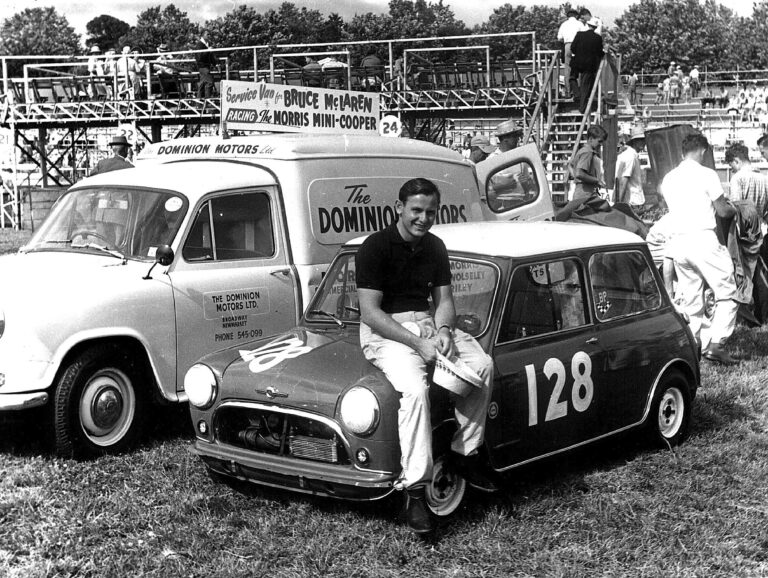data-animation-override>
“On day one, it was driven off the car yard. On day two, it was punished on the drag strip”
Imagine walking into your local car dealer, buying the most powerful car you can afford, then taking it home, fitting slicks to it and stripping it out. With the price of things these days, that’s a pretty unlikely scenario. But back in 1966, when this Chev Biscayne rolled off the yard of Floyd Hughes Chevrolet in Council Bluffs, Iowa, that’s exactly what it was destined for.
The new owner was a 19-year-old, by the name of Daryl Arrowsmith. What he lacked in age, he made up for with youthful enthusiasm and knowledge of what car would best suit his needs. Wanting to go drag racing, those needs were pretty basic: the car had to have big power, a four-speed manual and be as lightweight as possible.

While these days it might seem like an odd thing to classify a Biscayne — which is essentially a low-spec Impala (but don’t call it an Impala unless you want a clip around the ears from Mark) — as lightweight, coming from the factory without frills such as a stereo, power steering, electric windows or the likes, that’s exactly what the Biscayne was.
With it being as no-frills as can be, yet having been fitted in the factory with an L72 425hp, 427ci big block, and four-speed, experts have calculated that this car is one of only around 20 ever made. It’s only today in the modern muscle car wars that those types of power figures are being matched, so you can only imagine how impressive the car was 47 years ago!
Back in those days, local Auckland businessman and car enthusiast Mark Barton had just been born, but he grew up to have a serious love for cars and all things fast. While at the time he didn’t know what a Biscayne was, in the years that passed, he not only found out, but became quite a knowledgeable chap on the subject. It wasn’t just that he liked to know things about obscure vehicles; rather, he knew that one day he wanted to own one, and this is what sent him on the quest for knowledge.

Upon selling a very cool Mercury Comet in 2012, Mark figured it was now or never to tick Biscayne ownership off his bucket list. The dollar was good, business was doing well, and the Comet sold for a decent price. So finally, all the stars had aligned to make it a reality.
Of course, then came the challenge of actually finding a car.
With only a very small number of L72 cars ever produced in a Biscayne body, many being destroyed along the way, and others essentially missing in action, the pickings were very slim — even more so when potential sellers found out he planned on taking the car out of America. Add to this mix a few people claiming to have genuine cars, and wanting genuine money for cars that turned out to clearly be replicas, and the path to Biscayne ownership wasn’t an easy one.

With his determination, the help of friends abroad, and much searching, this very car came up, and it was as genuine as genuine could be, complete with a full, documented history.
After young Daryl Arrowsmith bought the car in 1966, he raced it at Wichita Dragway, Omaha Dragway, Kansas City Dragway, Thunder Valley Dragway, and others as often as he could before deciding it was time to let it go. Knowing how tough the car was, his brother Ron stepped up to take ownership. While not so keen on heading to the strip, he was every bit as keen on racing, and the story goes that the car was unbeaten on the streets of Iowa …
Fast forward to 2013, and after Mark had verified it was the real deal, the car, complete with just 45,000 original miles on the clock, was soon on its way to New Zealand. How the hell Mark kept the secret to himself that he’d found one, and that it was coming, no one quite knows, but when news broke that he had the car here, it’s fair to say word spread quickly.

All L72-powered cars have become what legends are made of, and are obviously very desirable collector’s items. Better still, the car Mark found had been factory optioned with the F41 suspension package, which sees stiffer front springs and extra leaves in the rear, making it even more special. Of course, the ‘cheater slicks’ the car now wears were never an option from the factory, but they do leave no doubt as to the car’s intentions.
The 427ci L72 engines came about to take full advantage of Nascar’s cubic-inch limit, and in 1966 were available in Corvettes and full-size Chevs, such as the Biscayne and Impala. Originally rated at 450hp, the engines were soon dropped to 425hp. It wasn’t that they didn’t make the stated amount of power — quite the opposite! The cars were underrated if anything, and the drop in rated power was just to avoid insurance concerns. Quite how GM slid that under the radar, we’re not quite sure!

Since the 396ci big blocks offered in 1965 vehicles provided a similar power rating (rating, not actual output), any driveline weaknesses had been taken care of by the time the 1966 cars were produced. Items such as 12-bolt diffs and rear sway bars were stock on high-powered cars, and understandably ordered by many owners of older vehicles.
A total of 1856 full-sized Chevs were sold with the L72 option, most of which would have been Impalas, both two-door and four-door, with a few station wagons thrown in for good measure (how cool would that be). As a comparison, 105,884 were sold with the more sedate 325hp 396ci L35 engine.

Besides the engine package, Mark’s car, like all L72 cars in ’66, came equipped with a factory dash tacho that sees the redline at a hefty 6000rpm, of which the solid lifter-equipped engines can happily reach.

Somewhere along the line a pair of Stewart Warner ‘Green Line’ gauges have wisely been fitted to keep an eye on oil pressure and water temperature too.
The engine itself has been played with a bit over the years. These days it runs a roller camshaft and 850cfm Holley carb along with a twin 2.5-inch exhaust that can best be described as being as subtle as a sledgehammer.

With the four-speed M21 Muncie manual gearbox being backed by a seriously heavy clutch, you’d think the car would be a pig to drive in traffic, but apparently that’s not the case at all. Mark’s also complimentary about the car’s unboosted four-wheel drum brakes, stating they’re far better than what his 1970 Challenger had (NZV8 Issue No. 32).

With that drivability, for now at least, Mark’s only plan is to enjoy the car, getting it out and about as often as possible. At some stage he says it’ll get a full body-off restoration, but until that point he’ll drive the pants off it.

And don’t go thinking just because it’s rare it’ll be driven gingerly, as he’s already sworn he’ll beat up on it every chance he gets, just as it was beaten up on from day two … It didn’t break then, so it’s not going to break now, and after all, cars are made to be driven, right? No matter how rare and precious they may be!
Mark’s Biscayne L72 was featured in NZV8 Issue No. 99 (August 2013). You can grab a copy here.
Specs:
- Engine: 427ci big-block Chev, roller cam, 850cfm Holley carb, exhaust cut-outs, twin 2.5-inch exhaust
- Driveline: M21 Muncie four-speed manual, heavy-duty clutch, original Lakewood scattershield, 12-bolt posi traction diff, 4.10:1 ratio
- Suspension: F41 suspension package, factory rear sway bar
- Brakes: Unboosted drums all-round
- Wheels/Tyres: 15-inch steel rims, 10.00-15 Firestone (DOT) cheater slicks
- Exterior: Stock Danube Blue paint, front tow points
- Interior: Stock re-trim, factory dash tachometer, Stewart Warner Green Line gauges
- Performance: 450hp (stock)


